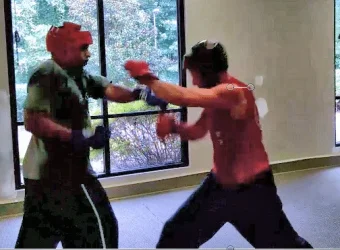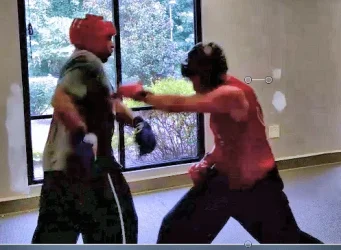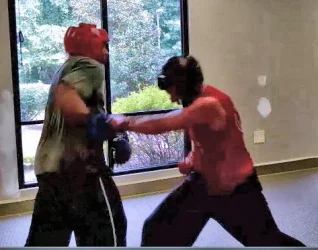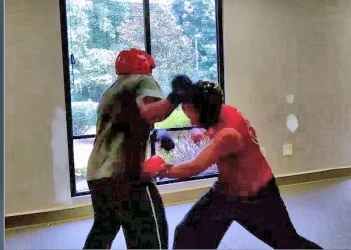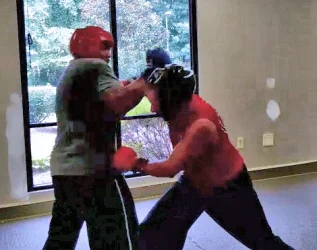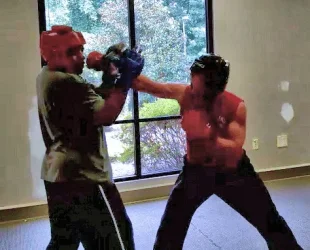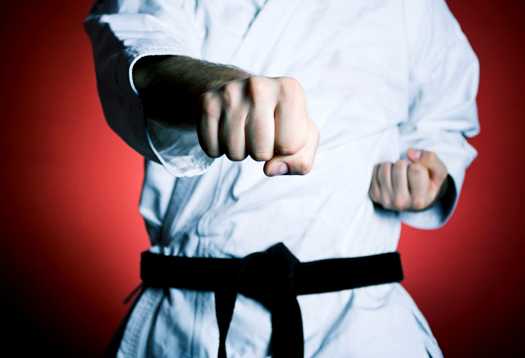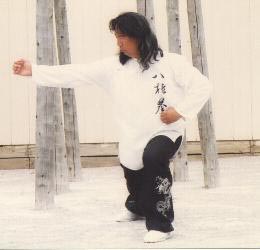Many of us have probably heard others say mention how TMA practitioners chamber their fists is not realistic to actual fighting. We would never see anyone chamber their fist like this in a real fight. It's an outdated technique. which is we don't see it in MMA. blah blah blah.

I'm pretty sure that there are some beginner martial artist out there who really want to know what the deal is about the chambered first. Do people use chambered fist like the guy in the picture above? The short answer is yes. Below is a picture of me sparring. I originally posted this image to talking about kicking people in the ribs and making your opponent commit. And it occurred to me that I have a text book TMA chambered fist. In the image, I'm transitioning into a thrust punch which
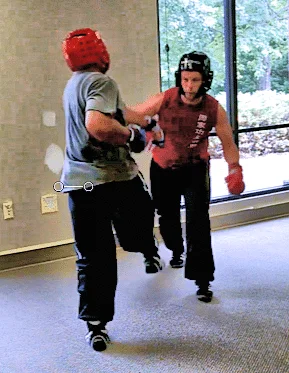
In the image I'm transitioning into a thrust punch. And in drills this is how the one of our thrust punches start off as.
So what is the value of chamberig the fist? It depends on what technique you are doing. In this particular case, By having my hand chambered like this, I can put more weight and power into my punch, Chambering my punch like this will also make my punch straight. Elbows out punches are usually weaker than elbows in punches and aren't as accurate. Many times people expect to see things exactly like in the form or drill, so if I'm standing in a horse stance doing punches then they expect to see that same thing in the fight. Sometimes you will see exactly what was practiced in the form, but other times you'll see component of things that you drilled.
In Jow Ga kung fu, we do a lot of chambering of the fist. Traditional arts in general do a lot of fist chamabering and there are many people who think it's a waste. For me there is very little about what's in the forms that are a waste, even if it seems like "no one would ever fight with a chambered fist" I'm willing to bet that it's more common than we think. By the way if you chamber your fist during training then it will get to a point where you don't even realize you are doing it. This vidoe is about 4 or 5 years old and I'm just now realizing that I have a chambered fist in this video.
Keep training hard and trust your techniques.
I'm pretty sure that there are some beginner martial artist out there who really want to know what the deal is about the chambered first. Do people use chambered fist like the guy in the picture above? The short answer is yes. Below is a picture of me sparring. I originally posted this image to talking about kicking people in the ribs and making your opponent commit. And it occurred to me that I have a text book TMA chambered fist. In the image, I'm transitioning into a thrust punch which
In the image I'm transitioning into a thrust punch. And in drills this is how the one of our thrust punches start off as.
So what is the value of chamberig the fist? It depends on what technique you are doing. In this particular case, By having my hand chambered like this, I can put more weight and power into my punch, Chambering my punch like this will also make my punch straight. Elbows out punches are usually weaker than elbows in punches and aren't as accurate. Many times people expect to see things exactly like in the form or drill, so if I'm standing in a horse stance doing punches then they expect to see that same thing in the fight. Sometimes you will see exactly what was practiced in the form, but other times you'll see component of things that you drilled.
In Jow Ga kung fu, we do a lot of chambering of the fist. Traditional arts in general do a lot of fist chamabering and there are many people who think it's a waste. For me there is very little about what's in the forms that are a waste, even if it seems like "no one would ever fight with a chambered fist" I'm willing to bet that it's more common than we think. By the way if you chamber your fist during training then it will get to a point where you don't even realize you are doing it. This vidoe is about 4 or 5 years old and I'm just now realizing that I have a chambered fist in this video.
Keep training hard and trust your techniques.

